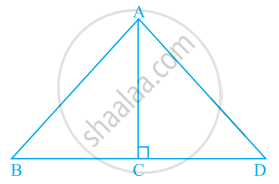Advertisements
Advertisements
प्रश्न
Find the area of the triangle ABC with A(1, −4) and mid-points of sides through A being (2, −1) and (0, −1).
उत्तर
Let the coordinates of points B and C of the ∆ABC be (a1, b1) and (a2, b2), respectively.

Q is the midpoint of AB.
Using midpoint formula, we have
`(0,-1)=((a_1+1)/2,(b_1-4)/2)`
`=>(a_1+1)/2=0 `
⇒ a1=−1 and b1=2
Therefore, the coordinates of B are (−1, 2).
P is the midpoint of AC.
Now,
`(2,-1)=((a_2+1)/2,(b_2-4)/2)`
`=>(a_2+1)/2=2`
⇒ a2=3 and b2=2
Therefore, the coordinates of C are (3, 2)
Thus, the vertices of ∆ABC are A(1,−4), B(−1, 2) and C(3, 2).
Now,
Area of the triangle having vertices (x1, y1), (x2, y2) and (x3, y3) = `1/2`[x1(y2−y3)+x2(y3−y1)+x3(y1−y2)]
∴ Area of ∆ABC = `1/2`[x1(y2−y3)+x2(y3−y1)+x3(y1−y2)]
= `1/2`×[1(2−2)+(−1)(2+4)+3(−4−2)]
= `1/2`(−6−18)
= `1/2` (−24)
=−12
Since area is a measure that cannot be negative, we will take the numerical value of −12, that is, 12. Thus, the area of ∆ABC is 12 square units
संबंधित प्रश्न
Prove that the points (a, b + c), (b, c + a) and (c, a + b) are collinear
Find the area of the triangle formed by joining the mid-points of the sides of the triangle whose vertices are (0, -1), (2, 1) and (0, 3). Find the ratio of this area to the area of the given triangle
Find the centre of a circle passing through the points (6, − 6), (3, − 7) and (3, 3).
Find the value of k so that the area of the triangle with vertices A (k+1, 1), B(4, -3) and C(7, -k) is 6 square units
The area of the triangle ABC with the vertices A(-5, 7), B(-4, -5) and C(4, 5) is ______.
Find the value of m if the points (5, 1), (–2, –3) and (8, 2m) are collinear.
If `D((-1)/2, 5/2), E(7, 3)` and `F(7/2, 7/2)` are the midpoints of sides of ∆ABC, find the area of the ∆ABC.
The area of ∆ABC is 8 cm2 in which AB = AC = 4 cm and ∠A = 90º.
Area of a right-angled triangle is 30 cm2. If its smallest side is 5 cm, then its hypotenuse is ______.
In the given figure, ratio of the area of triangle ABC to the area of triangle ACD is the same as the ratio of base BC of triangle ABC to the base CD of ΔACD.

